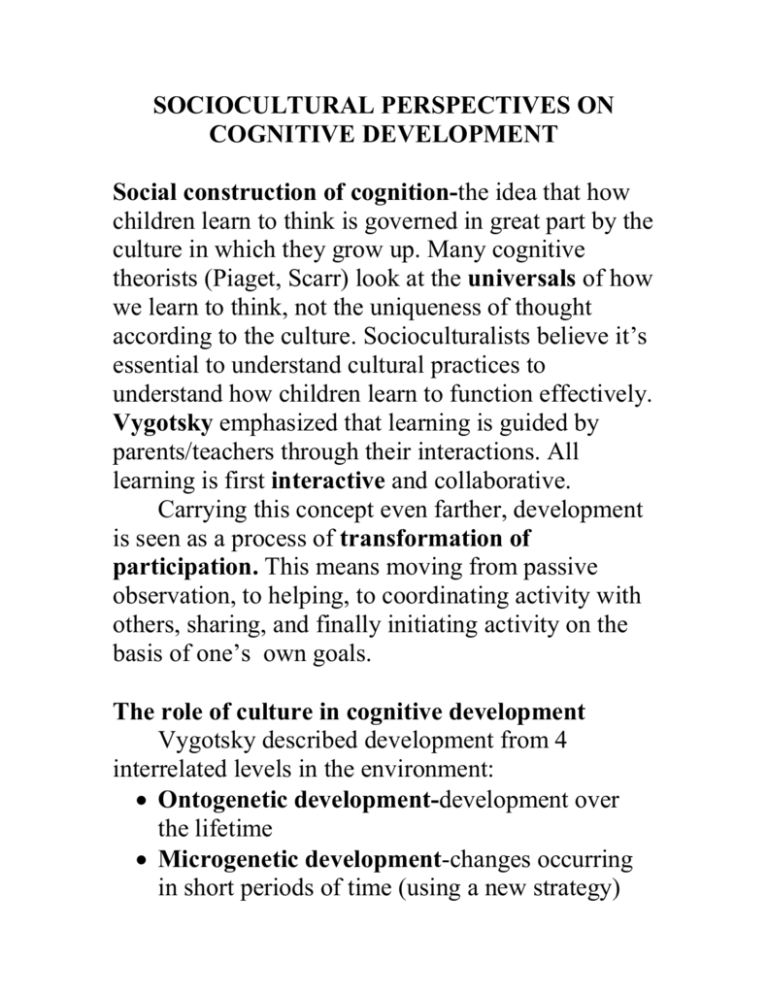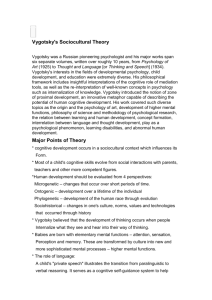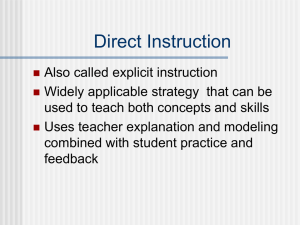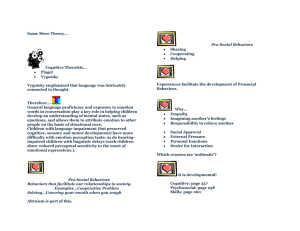The role of culture in cognitive development
advertisement

SOCIOCULTURAL PERSPECTIVES ON COGNITIVE DEVELOPMENT Social construction of cognition-the idea that how children learn to think is governed in great part by the culture in which they grow up. Many cognitive theorists (Piaget, Scarr) look at the universals of how we learn to think, not the uniqueness of thought according to the culture. Socioculturalists believe it’s essential to understand cultural practices to understand how children learn to function effectively. Vygotsky emphasized that learning is guided by parents/teachers through their interactions. All learning is first interactive and collaborative. Carrying this concept even farther, development is seen as a process of transformation of participation. This means moving from passive observation, to helping, to coordinating activity with others, sharing, and finally initiating activity on the basis of one’s own goals. The role of culture in cognitive development Vygotsky described development from 4 interrelated levels in the environment: Ontogenetic development-development over the lifetime Microgenetic development-changes occurring in short periods of time (using a new strategy) Phylogenetic development-changes over evolutionary time, understanding species’ history Sociohistorical development-changes within a culture that generate new values, technology We come into the world with a few mental functions that are capable of being transformed by the culture into more sophisticated mental processes- higher mental functions. (We have the neural capability of preserving experiences in memory, but in the beginning of life memory is only about sensation and physical experiences. Later we develop the ability to symbolize with language and imagination and our memory expands dramatically.) Tools of intellectual adaptation are cultural shortcuts that allow more expansive mental abilities. Computers, adding machines, abacus, writing. So not only do these things help us think, they teach us how to think. (One reason Asians do have a better mastery of math and higher math concepts is because of early experience with the abacus.) Research shows that Chinese children have an edge in counting as early as age 4, due to the Chinese number-naming system, which is completely base-10. After kids get to counting from 20 up, American children have an equal ability, but our 10s are confusing for children. Culture also stresses what is important to learn & master. The general genetic law of cultural development describes a dual-nature of cognitive development. It begins with a social process, then becomes internalized and psychological. To understand children’s advances intellectually, you must examine the context of their discoveries. How are they learning from peers, tutors, models? Vygotsky called this guided learning. Tutors offer strategies in problem-solving that children rarely stumble on themselves. The Zone of Proximal development is the difference between a children’s independent level of accomplishment and his/her level of function with some guidance or tutoring. This level of collaboration will result in the child internalizing skills and tricks and rising to a higher level of independent mastery. Scaffolding occurs as helpers, teachers, older, more experienced peers tailor their aid to the learning ability of the learner. More competent learners trigger more sophisticated helping techniques in the helper. The prompts are gradually drawn away as the child succeeds more independently without help. Scaffolding is used within the ZPD. The most effective techniques recognize the needs of the learner. Some need more encouragement and support, others need more freedom to explore and try things. Some children are simply more driven to learn and explore. Others are more passive, even fearful of failing by nature. Guided participation is the interaction between people as they engage in shared activities. So older children can help younger ones, peers can help one another, as well as teachers help students. It is the casual activities that people share in which there are opportunities to expand understanding. Cognition is shaped in these teachable moments. This is the idea behind doing apprenticeships in a vocation. The more children are included in everyday activities, the more confidence they develop, as well as ease at learning a wider variety of skills. Children in our culture have been excluded more and more from the activities of parents and education has been handed over to professionals in a formal setting. The Japanese, on the other hand, simply engage in questioning of children in a variety of environment, to enhance their knowledge in general, not for a specific purpose.(context-independent learning) Language in general usage is also an expansion of education. It helps if the language used at home is useful for school. Reading to children links to reading skills in the child later. Interactive story reading stops to ask the child what might happen next, suggest possibilities. After one month of this interactive reading, children in the exp. Group were 8.5 mo. ahead of the control group in verbal expression. (They were equal at the beginning of the study). Encouraging active participation in reading enhances literacy & language development. Talking to children also enhances literacy, but it means interactive talking, elaborations on events shared, making associations with other events. Talking at children is not very helpful (which may be one reason twins learn to talk later- moms tend to give directives to multiple children, not interact). Play is another opportunity for guided development, especially learning symbolic play. Pretend play, especially how complex it is, is an indication of cognitive development. It represents the way kids understand the world, schemas, concepts. It requires a playmate to develop much symbolic play. It helps if it’s an older, more skilled playmate. This play also helps children develop empathy and understanding of others’ feelings & thoughts- a theory of mind. Different cultures teach these things in different ways. American middle-class parents use more verbal instruction and structure the learning environment. Other cultures rely on children observing the adults’ behavior, or giving nonverbal demonstrations. In these cultures children develop more astute powers of observation than here in US. Vygotsky believed the learning environment should be interactive. He thought the child’s level of understanding should be assessed in order to structure guided learning activities at that child’s level. Progress should be monitored so that help could be fine-tuned and phased out as the child no longer needs it. Teachers should arrange cooperative or collaborative learning exercises to allow students to help one another- both members benefit. Group projects are valuable if they are designed well. They are effective because: They enhance motivation They require communication of ideas, persuasion and consideration of alternative ideas. Talk enhances more sophisticated problem solving. They use higher-quality strategies, generating ideas together they would not have come up with individually. Even so, collaborative learning may be a challenge for children in some cultures- the US especially since we emphasize competition and individual effort. Collaborative learning requires sharing and negotiation skills. Not all children have those. SOCIOCULTURAL PERSPECTIVES ON COGNITIVE DEVELOPMENT Social construction of cognition-the idea that how children learn to think is governed in great part by the culture in which they grow up. Vygotsky emphasized that learning is guided by parents/teachers through their interactions. All learning is first interactive and collaborative. Transformation of participation. The role of culture in cognitive development: Ontogenetic development Microgenetic development Phylogenetic development Sociohistorical development We come into the world with a few mental functions that are capable of being transformed by the culture into more sophisticated mental processes- higher mental functions. Tools of intellectual adaptation are cultural shortcuts that allow more expansive mental abilities. The general genetic law of cultural development describes a dual-nature of cognitive development. It begins with a social process, then becomes internalized and psychological. Vygotsky called this guided learning. The Zone of Proximal development is the difference between a children’s independent level of accomplishment and his/her level of function with some guidance or tutoring. Scaffolding occurs as helpers, teachers, older, more experienced peers tailor their aid to the learning level of the learner. Guided participation is the interaction between people as they engage in shared activities. Language in general usage is also an expansion of education. It helps if the language used at home is useful for school. Reading to children links to reading skills in the child later. Interactive story reading stops to ask the child what might happen next, to suggest possibilities. Talking to children also enhances literacy, but it means interactive talking, elaborations on events shared, making associations with other events. Play is another opportunity for guided development, especially learning symbolic play. This play also helps children develop empathy and understanding of others’ feelings & thoughts- a theory of mind. Teachers should arrange cooperative or collaborative learning exercises to allow students to help one another- both members benefit. Group projects are valuable if they are designed well. They are effective because: They enhance motivation They require communication of ideas, persuasion and consideration of alternative ideas. Talk enhances more sophisticated problem solving. They use higher-quality strategies, generating ideas together they would not have come up with individually.






